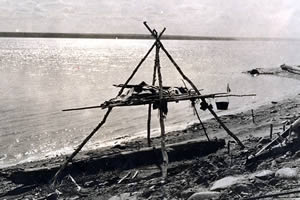|
Pre-Contact Graves |
|
|
In the old days when someone died, they left their body wrapped in clothing
on a scaffold. Over time the elements would reclaim the remains. Sometimes the
possessions of the dead were burned; sometimes they were left on the ground
near the scaffold. If a person died on the barrenlands then the body would be
left on the ground. The elements reclaimed the bodies quickly, and people would
stay away from these areas for a while. It was only after the Roman Catholic
priests arrived that people started digging graves. It’s a lot of work
digging graves, especially in winter when the ground is frozen solid, but since
the 1850s that’s how it’s been done. People would put a fence around
the grave to make it look nice and so you’d be able to see it from a distance.
Some people say the fence keeps the spirit from travelling. Whenever you pass
a grave, take the time to stop and fix it up. Clean out the weeds, leave a small
gift for the dead, say a prayer, and then continue on your way. This is the
way to be respectful.
|
|
|
| |
|
| |
|
 |
| A burial platform on the bank of the Mackenzie River, 1922 (NWT Archives/N-1979-004-0109(1830008)) | |
|
|

